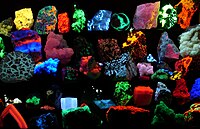
Photo from wikipedia
Abstract Random copolymers (poly(ABSt-co-St)) consisting of avobenzone-BF2 complex monomer (ABSt) and styrene (St) were synthesized and used for emission color tuning including white-like emission in the solid state using St… Click to show full abstract
Abstract Random copolymers (poly(ABSt-co-St)) consisting of avobenzone-BF2 complex monomer (ABSt) and styrene (St) were synthesized and used for emission color tuning including white-like emission in the solid state using St units as a spacer. The emission color of ABSt in the resulting copolymers changed from green to blue via bluish-white by changing the content of St. The fluorescence quantum yields of the polymers in the solid state were relatively high (Φf = 0.30–0.51) independent of the composition contents. The polymers have two main emission bands around 440 and 540 nm, which were derived from the emission of single-molecule and amorphous aggregation, respectively. The fluorescence color changed according to a change in the ratio of the fluorescence intensity at 440 and 540 nm (F440/F540). The absorption and fluorescence properties of the polymers in tetrahydrofuran were independent of the composition ratio of ABSt and St, which indicates no intermolecular interaction between avobenzone-BF2 (AB) fluorophores in the intra-polymer chain. The emission color of all polymers in the solution was blue and the fluorescence spectra were the same as that of ABSt in the solution. Thus, emission color changes observed in the solid state were mainly derived from the intermolecular interaction between AB fluorophores in inter-polymer chains because the polymers intertwined each other in the solid state. When the polymers in the solid state were annealed, F440/F540 increased and all of the fluorescence spectra became similar to that of monomer emission according to the arrangement change of the polymer chain. It is concluded that emission color changes of the polymers are mainly derived from intermolecular interaction between AB fluorophores in the inter-polymer chains. We have demonstrated that poly(ABSt-co-St) forms excellent homogeneous fluorescence polymer films. In contrast, the mixture of methoxy AB (ABOMe) and poly(St) undergoes crystallization even in the low content of ABOMe in poly(St).
Journal Title: Dyes and Pigments
Year Published: 2020
Link to full text (if available)
Share on Social Media: Sign Up to like & get
recommendations!